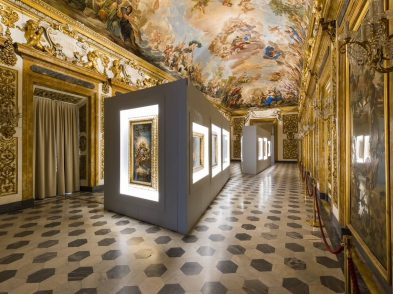Italy is confronting the impact of migration. Although less than 9 percent of its population was born outside the country (below the average for European Union member states), immigration has risen dramatically since 2001 and poses questions about national borders as populations move in search of prosperity and security. The decision, therefore, by the Centre for Contemporary Culture Strozzina to examine in its latest exhibition how artists interpret the sensitive themes of international frontiers and territorial identity is timely. As the works on show demonstrate, its title, Unstable Territory, appears especially appropriate: the dream of global mobility is a nightmare for some as traditional barriers hold fast.
With the arrival of swift, efficient and varied forms of transport and communication, the pace of global integration has hastened in recent decades, producing huge profits, profound social change and numerous contradictions. The movement of money and knowledge is no longer restricted by national and linguistic frontiers. The growth of supranational organisations in government, finance, security and humanitarian aid has been one of many responses to this development.
Yet borders everywhere are now policed with growing vigour; the world map absorbs the birth of new, small nations; and the migration of populations ignites tense political debate, especially in Europe.
The show at the Strozzina opens with the wall-sized projection of Israeli artist Sigalit Landau spinning a hula hoop of barbed wire around her hips. The visitor can read into this disturbing image an allusion to the Middle Eastern conflict, with Israel at its centre and the ineradicable scarring that geopolitics is inflicting on the region.
As people move away from poverty and conflict towards better opportunities abroad, voices are raised to restrain them and question their effect on cherished images that host communities have of themselves. While the free flow of capital is universally welcomed, the struggle to turn strangers into citizens increasingly provokes hostility.
The enquiry pursued by the Strozzina’s show reflects the international nature of this dichotomy. Its 10 contributions span the globe and the individual artists involved come from 11 countries, with experience of working in many more.

Paulo Nazareth, Untitled
Brazilian artist Paulo Nazareth has travelled across continents, much of it by foot. Photographing himself as a cultural nomad in foreign cities and dusty landscapes, he fits in as much as he stands apart. Nazareth’s journey echoes his own multicultural heritage, one rooted in several cultures that render man-made frontiers irrelevant. Walking represents Nazareth’s belief that people become their own territories and that the essence of the modern world is its fluidity.
The tree houses that Tadashi Kawamata has attached to the exterior and courtyard elevations of Palazzo Strozzi imply a less confident outlook for new arrivals in foreign territory. Structurally at odds with their host, these makeshift nests appear ingenious but also desperate and illicit, perching high up as if seeking protection from other creatures rather than from the elements.
Indeed, the mood across the Strozzina’s rooms is anxious and unsettling. The many walls and low ceiling of the venue’s interior seem to draw the visitor into the mindset of the harried, marginalised migrant, like those caught in an interminable bureaucratic limbo by the passport authorities in Oliver Ressler and Zanny Begg’s video about statelessness, ironically titled The Right of Passage.
By contrast, Paolo Cirio, an Italian based in London, traces the ease with which high finance relocates itself to wherever the most favourable fiscal environments exist. The experiences of migrants tackled by other artists converge with Cirio’s institutional critique of corporate tax avoidance in the disputed realm of social responsibility. His response to these discreet and lucrative schemes is a scheme of his own that democratises access to these benefits and the companies that enjoy them.

Richard Mosse, Platon, North Kivu, Eastern Congo
Nonetheless, physical hardship emerges as the sad consequence of the clash between international mobility and local interests. Italy’s The Cool Couple duo recalls the hopes of anti-Soviet Cossack troops, whose resettlement in the harsh Carnia region of northeastern Italy in 1944–45 was short-lived and soon forgotten after they were transported back to a hostile Russia.
The aesthetics of representing suffering is a curious feature of this show. South African photographer Jo Ractliffe chose the generic black-and-white format of photojournalism to record the arid legacy of civil war in Angola. The fledgling nation became a cold war battleground when the local combatants’ Cuban and South African allies entered the fray with a destructive effect that remains to be mended.
Richard Mosse from Ireland, however, rethinks the depiction of these intractable conflicts. His multi-screen film observes the violation of present-day Democratic Republic of Congo by attrition so complex and murderous it renders conventional visual reportage inadequate. Mosse turned infrared film devised for armies to detect camouflaged enemies on the chaos to seek meaning. The most striking result is the bizarre bubblegum palette of pinks and reds that accords every scene, whether of thriving landscape or bloody death, a perverse, surreal beauty.
Mosse’s cogent, subtle metaphors offer a lesson in communicating a perplexing and pressing topic memorably. The mass media have largely forsaken Congo, but this artist’s scarifying images dare anyone to turn away.
Unstable Territory: Borders and Identity in Contemporary Art
Until January 19, 2014
Centre for Contemporary Culture Strozzina (CCCS)
Palazzo Strozzi, Piazza Strozzi 1, Florence






